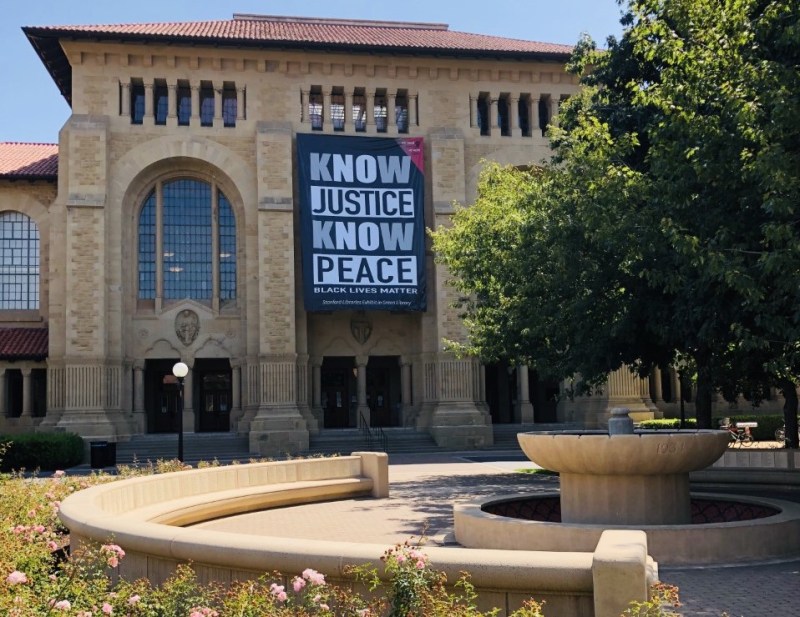On the morning of Sept. 4, a small group of library staff gathered near the Bing Wing entrance of Cecil H. Green Library to watch a large, black-and-white banner unfurled over the west-face of the building. The banner, designed by Kelly Fields, the Information Editor at Stanford Libraries, reads, “know justice, know peace” — a play on words, using a common protest chant. The banner’s installation marked the opening of Green Library’s “Say Their Names — No More Names” exhibit, a project spearheaded by Felicia Smith, the head of Learning and Outreach at Stanford Libraries. For around 12 minutes, Fields and Smith addressed their colleagues and hundreds of virtual viewers watching Facebook Live.
“It was really gratifying to see a Black Lives Matter symbol that large hanging up on the library … I wish there’d been something like that when I was a graduate student there,” said Harriett Jernigan, a lecturer in PWR, who proofread the exhibit’s text, which was written by Smith.
“Let these names — and the too many other names — kickstart your pursuit to know justice and to know peace,” Smith said to the audience as sign installers hoisted the banner higher and higher toward the sky.
“This is fabulous. I’m getting emotional watching alone — I can imagine the impact on students, staff, faculty and families walking through campus,” Eric Abrams, the chief inclusion officer at Stanford’s Graduate School of Education, commented through the chat feature.
“Say Their Names — No More Names” remembers the victims of police brutality and racist violence, displaying names, stories and photos — some well-known, others not. The exhibit is organized into three parts: “3 T’s (Systemic Racism),” “330 Names” and “65 Stories.” “3 T’s (Systemic Racism)” studies three historical examples of institutional violence perpetrated against Black Americans, such as the Tuskegee Syphilis Experiment. “330 Names” is a non-exhaustive list of victims, ranging from the early 20th century to the present, and “65 Stories” is an in-depth look at some of them. “Say Their Names — No More Names” features diverse stories within the Black community, including those of underrepresented groups like transgender and gender non-conforming people who are often excluded from discussions about racial justice.
“As a library system, it is part of our core values to always strive to be better, and do more in building research collections that include, represent and preserve all perspectives, including those from underrepresented communities, so that scholars, students, public policy figures and ordinary citizens might learn, debate and ultimately take corrective action through peaceful means,” Michael Keller, Vice Provost for University Libraries, told Stanford News.
The goal of “Say Their Names — No More Names” is to advocate for racial equity while remembering the victims of structural racism.
“In other exhibits, what you see are demonstrations of what happened to a person and who did it to them,” said Jernigan. “This exhibit is more about not just explaining what happened to that person but also who that person was, how they were loved, how they were understood outside of the context of their trauma and their murder.”
“Say Their Names — No More Names” is a concrete action, on the part of Stanford Libraries, demonstrating their support of the Black Lives Matter movement. The exhibit exists both online and in person. On the library’s website, one can view text and photos curated by Smith and her co-workers. Within the library, informational posters cover the glass walls on the first floor of the East Wing, and the pillars that frame the grand staircase in the West Wing. On the paneled windows of the director’s office, victims’ names overlay the glass panes. Throughout the exhibit, there are reminders of those for whom it was made.
In her bio, Smith describes librarians as “keepers of the light and protectors of our shared memories.” Through research and conversations with some of the victims’ families, Smith tapped into individual memories to build a fuller, deeper collective memory of those lost. In an interview with The Daily, she recalled speaking with Stephon Clark’s mother, and how that conversation informed his story in the exhibit.
Between the exhibit’s premier and this article’s publication, the livestream of the banner installation, which is still available on Stanford Libraries’ Facebook timeline, has been viewed over 3,000 times.
“I know a lot of Black staff on campus who were watching this, and when I sent out that announcement, the press release, I got such an overwhelming response from the Black staff, saying, like, ‘Thank you for seeing me,’” said Smith. “It seems to me that … a lot of Black staff feel that the University [doesn’t] see us … I just think that message needs to be conveyed to the administration — that the steps they’ve taken are appreciated but … they [Black staff] need more support.”
Contact Chasity Hale at chashale ‘at’ stanford.edu.
